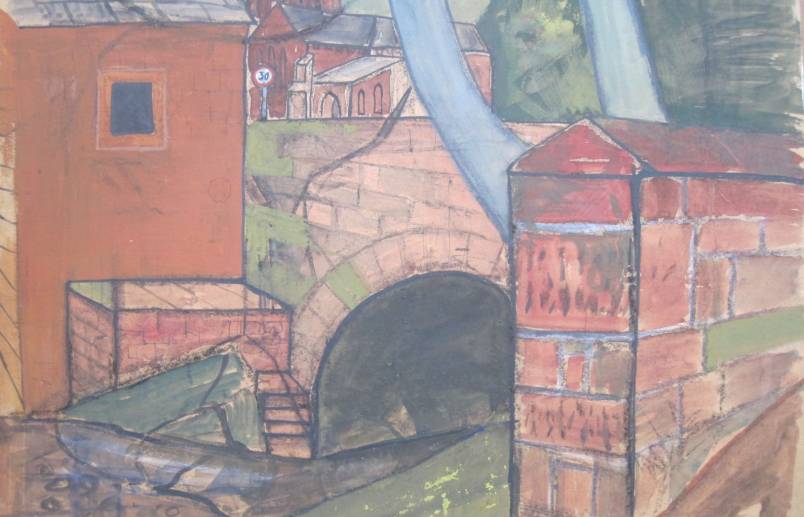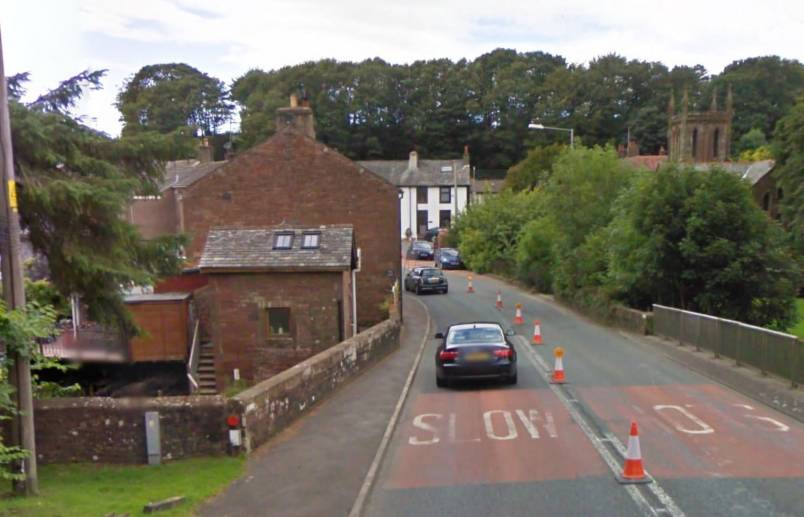NORTHERN EXPOSURE
Date Posted: 6th September 2019


A Percy Kelly charcoal drawing, Church by the Bridge dated 1958, sold at Mitchells Auction a few months ago. I was pleased when the successful bidder got in touch to tell me she had found exactly where the artist had stood to make it. Although it had passed through my hands at some point, I had no idea it was Calder Bridge. She told me of the frisson of excitement she felt as she stood where Kelly had stood to take the photograph which she sent to me. Calder Bridge hasn’t changed much in 50 years but comparing his drawing with the photograph you can see how an artist has the freedom to play with perspective, composition and atmosphere to make a good painting. I then realised that I have a painting in gouache from the same standpoint so I have now given it its proper title Church at Calder Bridge and put it on the Kelly web site www.percykelly.co.uk/gallery in the Paintings for Sale box.
People like titles. You can see them at exhibitions peering at the label first, sometimes giving it more time than the work of art. People are curious to work out where the artist sat or stood to create a particular landscape. When Kelly died in 1993 and his work came to Castlegate House there were hundreds of his works to be recorded and catalogued but few had titles. He painted, not only in Cumbria but in Brittany, Cornwall, Wales, Norfolk, Yorkshire and Scotland, so it was a daunting task and each had to have a title to differentiate between them. If only Percy had given us a clue to the places he drew and painted it would have made my cataloguing much easier but of course there was no point as he knew where they were and he wanted to keep them to himself! I acquired some of his sketch books from his family some years later which was a great help as he sometimes made notes on them but there are still Kelly’s out there with locations I’m unable to identify.
J M W Turner titled his work for posterity. Unlike Kelly he wanted fame and fortune. He made the watercolour Buttermere Lake with part of Cromackwater Cumberland – a shower more than 200 years ago in 1797. It’s a cumbersome title but it tells us a lot. The exact place where Turner found the inspiration for this breathtaking view was discovered only recently when Brackenthwaite Hows above Crummockwater was acquired by the National Trust from private owners amid much publicity. I couldn’t resist trying to find it of course and it was well worth the effort just to stand and survey the scene down the length of Crummockwater through Rannerdale Knots to Buttermere and the soaring height of Fleetwith Pike with Haystacks and Great Gable only faintly discernible through the cloud and mist from the place where JMW stood or sat – I even got the shower thrown in. You can always feel the weather in a Turner landscape. He was a master at conveying atmosphere.
Turner was 22 when he first visited Cumbria in 1797 as part of his Northern Tour travelling 1000 miles in 8 weeks by stage coach making paintings and sketches of castles, great houses and landscapes across the region. I stood where he had stood to make that painting last week and wondered how Turner, who is recognised as one of our finest landscape painters, had discovered this perfect vista. Did he walk over from Lanthwaite Gate as I had just done aiming for the highest point above the lake or did he walk down to the little pebble beach at the head of Crummockwater and climb up through the woods from there to get a better viewpoint? Maybe he stopped at Scale Hill and they pointed the way to it through the gate opposite. We can only speculate.
Although Turner’s comment on his visit was that it rained a lot, which comes as no surprise to us, he ventured north several more times giving us atmospheric paintings of Ullswater, Ambleside, Derwentwater, Windermere, and Whitehaven as well as Cockermouth Castle which you can see at Petworth. He showed some of them in the Royal Academy on his return to London in 1798 (He became a Royal Academician in 1790 aged 15.)
I am delighted to tell you that some of these Cumbrian based works are to be shown alongside paintings he made in Northumberland, Durham and Yorkshire at Tullie HouseMuseum and Gallery in Carlisle from October 19th 2019 to January 5th 2020 in an exhibition entitled Northern Exposure. This is a rare opportunity to see the work of one of our greatest landscape painters in this beautiful gallery space. I will give you more details of this landmark show as well as news of another exciting exhibition coming to Carlisle in my next newsletter.
